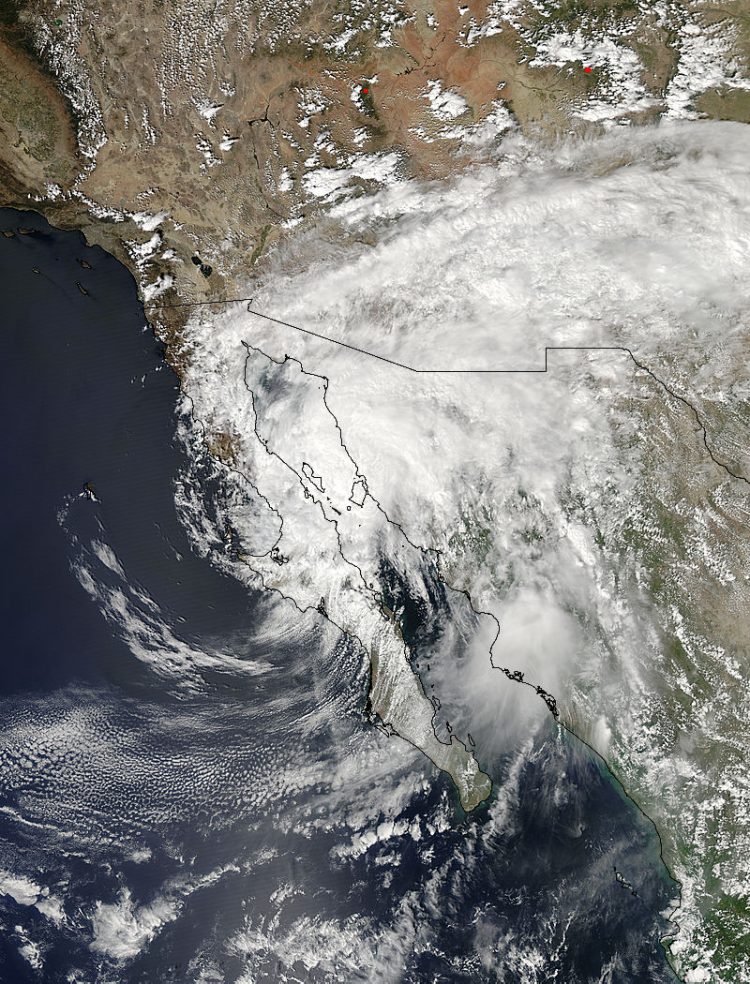NASA Sees Odile Soaking Mexico and Southwestern U.S.

On Sept. 16 at 20:50 UTC (4:50 p.m. EDT) the MODIS instrument aboard NASA's Aqua satellite captured this image of Tropical Storm Odile over Baja California. Image Credit: NASA Goddard MODIS Rapid Response Team
Odile had weakened to a tropical storm with winds of about 55 knots (63.3 mph) when the TRMM satellite flew over on September 16, 2014 at 0917 UTC (2:19 a.m. PDT).
Odile was still well organized and TRMM's Precipitation Radar (PR) measured rain falling at a rate of almost 130 mm (5.1 inches) per hour northeast of the tropical storm's center of circulation. The tops of some strong thunderstorms over the Gulf of California were reaching heights of 13km (8 miles).
On Sept. 17, Odile is weakening as it moves slowly northeastward across the northern Gulf of California while dropping heavy rainfall over portions of northwestern Mexico and the southwestern United States. A Tropical Storm Warning remained in effect for mainland Mexico from Bahia Kino to Puerto Penasco.
At 11 a.m. EDT on Sept. 17, the center of Tropical Storm Odile was located near latitude 30.6 north and longitude 113.3 west, about 50 miles (85 km) south-southeast of Puerto Penasco, Mexico. Odile is moving toward the northeast near 6 mph (9 kph).
On the forecast track the center of Odile is moving into northwestern mainland Mexico. Maximum sustained winds are near 40 mph (65 kph) and rapid weakening is expected as Odile moves over the mainland.
Tropical storm-force winds and heavy amounts of rainfall have been recorded today, Sept. 17. The National Hurricane Center noted that a wind gust to 41 mph (66 kph) was reported at Caborca in the Mexican state of Sonora during the morning hours. A rainfall total of 2.57 inches (62 mm) was observed at Caborca, Mexico.
The heavy rain that TRMM was measuring is expected to continue as Odile tracks slowly over mainland Mexico.
Moisture ahead of Odile is expected to produce rainfall amounts of 3 to 6 inches with isolated totals of 9 inches across southeastern Arizona and southwestern New Mexico, possibly extending into western Texas through Friday, September 19.
Text credit: Rob Gutro
NASA's Goddard Space Flight Center
Media Contact
All latest news from the category: Earth Sciences
Earth Sciences (also referred to as Geosciences), which deals with basic issues surrounding our planet, plays a vital role in the area of energy and raw materials supply.
Earth Sciences comprises subjects such as geology, geography, geological informatics, paleontology, mineralogy, petrography, crystallography, geophysics, geodesy, glaciology, cartography, photogrammetry, meteorology and seismology, early-warning systems, earthquake research and polar research.
Newest articles

High-energy-density aqueous battery based on halogen multi-electron transfer
Traditional non-aqueous lithium-ion batteries have a high energy density, but their safety is compromised due to the flammable organic electrolytes they utilize. Aqueous batteries use water as the solvent for…

First-ever combined heart pump and pig kidney transplant
…gives new hope to patient with terminal illness. Surgeons at NYU Langone Health performed the first-ever combined mechanical heart pump and gene-edited pig kidney transplant surgery in a 54-year-old woman…

Biophysics: Testing how well biomarkers work
LMU researchers have developed a method to determine how reliably target proteins can be labeled using super-resolution fluorescence microscopy. Modern microscopy techniques make it possible to examine the inner workings…





















